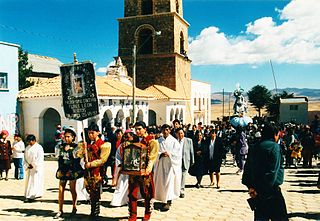
La Paz, officially Nuestra Señora de La Paz , is the seat of government of the Plurinational State of Bolivia. With 755,732 residents as of 2024, La Paz is the third-most populous city in Bolivia. Its metropolitan area, which is formed by La Paz, El Alto, Achocalla, Viacha, and Mecapaca makes up the second most populous urban area in Bolivia, with a population of 2.2 million, after Santa Cruz de la Sierra with a population of 2.3 million. It is also the capital of the La Paz Department.
The music of Bolivia has a long history. Out of all the Andean countries, Bolivia remains perhaps the most culturally linked to the indigenous peoples.

Bolivia is a country in South America, bordered by Brazil to the north and east, Paraguay and Argentina to the south, Chile to the west, and Peru to the west.

The La Paz Department of Bolivia comprises 133,985 square kilometres (51,732 sq mi) with a 2024 census population of 3,022,566 inhabitants. It is situated at the western border of Bolivia, sharing Lake Titicaca with the neighboring Peru. It contains the Cordillera Real mountain range, which reaches altitudes of 6.6 kilometers (22,000 ft). Northeast of the Cordillera Real are the Yungas, the steep eastern slopes of the Andes Mountains that make the transition to the Amazon River basin to the northeast. The capital of the department is the city of La Paz and is the administrative city and seat of government/national capital of Bolivia.

Inkallaqta is a monumental Inca site in central Bolivia. It is located in the Cochabamba Department, Carrasco Province, Pocona Municipality, approximately 130 kilometers east of Cochabamba. It was most recently excavated by Larry Coben. He believes that the site was used to perform rites for the ceremonial calendar. The site has several important structures such as the Kallanka. It was the largest single roofed room in the western hemisphere when it was built, and measures 78 by 25 meters. There's also an ushnu or a ritual platform on the site. The Torreon of Inkallaqta is also located on this site. Positioned on the western side of the site this six sided structure supposedly had calendrical or astronomical significance. There is a zigzag wall immediately north of the site which is meant to mark and protect it.

Bautista Saavedra is one of the twenty provinces of the Bolivian La Paz Department situated in the northwestern parts of the department. It was created on November 17, 1948 in honor of Bautista Saavedra Mallea (1870-1939) who was Bolivia's president from 1920 to 1925. The capital of the province is Charazani.

The Carnival of Oruro is a religious and cultural festival in Oruro, Bolivia. Originally an indigenous festival, the celebration later was transformed to incorporate a Christian ritual around the Virgin of Socavón. The carnival is one of UNESCO's Masterpieces of the Oral and Intangible Heritage of Humanity.
The Morenada is an Andean folk dance whose origins are still under debate. This dance is practiced mainly in Bolivia as well as in Peru and in recent years with Bolivian immigration in Chile, Argentina and other countries.

Charazani or Charasani is a small town in the South American Andes in Bolivia.
Mecapaca Municipality is the second municipal section of the Pedro Domingo Murillo Province in the La Paz Department, Bolivia. Its seat is Mecapaca. It is situated 28 km from the city of La Paz, the capital of the department and the seat of government for the country, and it stands at an elevation of 2,850 meters above sea level. According to the 2012 national census, the municipality of Mecapaca has a population of 16,027 inhabitants.

The Diablada, also known as the Danza de los Diablos, is an Andean folk dance performed in Bolivia, in the Altiplano region of South America, characterized by performers wearing masks and costumes representing the devil and other characters from pre-Columbian theology and mythology. combined with Spanish and Christian elements added during the colonial era. Many scholars have concluded that the dance is descended from the Llama llama dance in honor of the Uru god Tiw, and the Aymaran ritual to the demon Anchanchu, both originating in pre-Columbian Bolivia
Chacarilla Municipality is the third municipal section of the Gualberto Villarroel Province in the La Paz Department, Bolivia. Its seat is Chacarilla. It had 23 inhabitants in 2001.
Umala Municipality is the second municipal section of the Aroma Province in the La Paz Department, Bolivia. Its seat is Umala.

Calamarca or Qala Marka is a town in the La Paz Department in Bolivia. It is the seat of Calamarca Municipality, the fourth municipal section of Aroma Province. It lies on the Altiplano on the east side of the main road between La Paz and Patacamaya, about 60 km south of La Paz.
Umala is a location in La Paz in Bolivia. It is the seat of the Umala Municipality, the second municipal section of the Aroma Province.
Cañaviri is a small town in Bolivia. In 2010 it had an estimated population of 992.

Bolivians are people identified with the country of Bolivia. This connection may be residential, legal, historical or cultural. For most Bolivians, several of these connections exist and are collectively the source of their being Bolivian.
Jach'a Jawira may refer to:

The largest Alasitas fair is an annual month-long cultural event starting on 24 January in La Paz, Bolivia. It honours Ekeko, the Aymara god of abundance, and is noted for the giving of miniature items. Other fiestas and ferias throughout Bolivia incorporate alasitas into religious observances: The Fiesta of the Virgin of Copacabana and the Fiesta of the Virgin of Urkupiña, for example.
Kuntur Amaya is an archaeological site in Bolivia. It is located in the La Paz Department, Aroma Province, Umala Municipality, near Wayllani and Kuntur Amaya. The site was declared a National Monument on December 12, 2006. It is a place with burial towers (chullpa).








